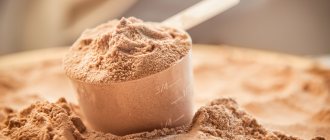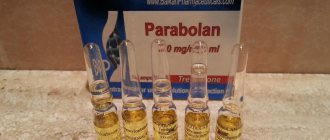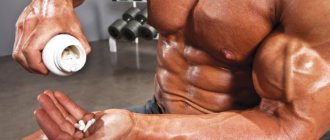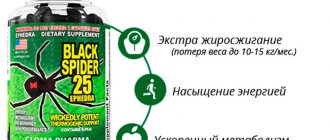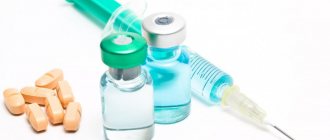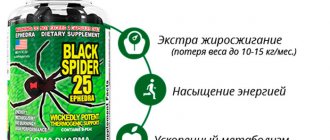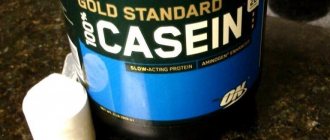- September 12, 2018
- Sports nutrition
- Tatyana Merzlikina
Protein is considered the most popular nutritional supplement in sports nutrition. But any athlete should know how to properly take this or that drug, in what dosage. Only well-chosen sports nutrition will have a positive effect. In the article we will talk about how to properly prepare protein, in what quantities to consume it, and at what time of day.
What are proteins for?
Protein is protein obtained industrially from foods high in protein. Protein mixtures are perfectly absorbed by the body, allowing you to increase muscle mass, lose weight and tolerate stress more easily. Each serving of protein contains more than 90% protein, so with the help of this supplement you can adjust your diet and get the amount of protein compounds you need per day.
It is worth noting that muscle tissue consists of 20% proteins, which are involved in the reproduction of DNA and RNA molecules and various biochemical reactions. In addition, protein mixtures allow you to cope with the following processes:
- Building muscle and connective tissue.
- Coordination of actions, transmission of nerve impulses.
- Delivery of oxygen, hemoglobin and nutrients to muscle tissue.
- Regulating the state of cells and metabolic processes to withstand intense stress.
- Improving the protective properties of the body.
During intense sports activities, a person needs an increased amount of protein. A serving of this supplement helps increase your daily protein intake.
How much protein do you need for optimal muscle growth?
Several clinical studies have been conducted to calculate the required amount of protein for the most efficient growth of muscle fibers.
A group of scientists from Canada's McMaster University conducted the Exercise Metabolism study, which involved a focus group of young people. Participants performed strength training, after which they consumed liquid egg whites, while the dose of protein in the drink varied and was 0, 5, 10, 20, 40 g.
During the experiment, scientists assessed the increase in muscle mass in each of the participants. It turned out that the most optimal muscle growth occurred in young people who consumed 20 g of protein. The study is posted on the website at the link, publication number - 10.1080/02640414.2011.619204.
In 2016, a group of British scientists from The University of Stirling published the results of a study on the required amount of protein to gain muscle mass. The focus group included 48 young people without chronic and acute diseases, with an average body weight of 80 kg. During the study, participants ate a protein-rich breakfast of 0.5 g/kg body weight. Three hours later, the volunteers performed strength exercises on their legs and buttocks. 10 minutes after exercise, participants consumed whey protein containing 0, 10, 20, and 40 g of protein.
© PixelsAway — depositphotos.com
Experts compared the activity of anabolic reactions using labeled urea and phenylalanine atoms. The results of the study coincided with the experiment of Canadian scientists.
The greatest effectiveness of muscle growth was achieved at a dosage of 20 g of protein:
- when using a supplement containing 10 g of protein, muscle growth was about 49%;
- a dosage of 20 g increased muscle protein synthesis by 56%;
- When consuming a highly concentrated 40 g supplement, the rate of phenylalanine metabolism and urea concentration increased, and the increase in muscle growth was practically no different from that in the focus group receiving 20 g of protein.
The study is listed on the website at the link ISRCTN92528122.
Compound
Protein shakes consist of 22 amino acids, 10 of which are essential, flavors and vitamin supplements. Each amino acid is essential for the proper functioning of body systems. Each element is important for human health. A lack of any amino acid leads to problems in the endocrine, immune, digestive and other systems. In addition, physical endurance decreases.
Protein formulations are divided into:
- Fast: these include whey, milk and egg - they are quickly absorbed and release a large amount of nutrients.
- Slow: casein and soy - they are taken before bed or to replace meals.
What are protein supplements made from? Proteins are obtained from common foods:
- Whey protein is obtained from whey.
- Casein from milk.
- Egg made from eggs.
- Soy from soybeans.
Complex protein includes several types of monoproteins.
Which protein is better to choose? Benefits of Whey Proteins
Whey proteins have a clear advantage over soy and other plant proteins in terms of increasing lean body mass (LEM) and muscle development (Hartman J et al., 2007).
Whey proteins, unlike other protein sources, due to their high content of essential amino acids (3960 mg of leucine, 1800 mg of isoleucine and 1760 mg of valine in one serving), contribute to the effective increase in muscle strength and power, recovery after physical activity, reduction of microdamage to skeletal muscles, accelerating the resynthesis of glycogen (the body's main energy reserve).
Whey proteins are a line of protein fractions including alpha-lactolbumin, beta-lactoglobulin, immunoglobulins and lactoferrin.
All these fractions are considered immunostimulating, which is manifested by a number of bioactive functions (Walzem RM, 2002; Marshall K., 2004):
- Prebiotic effects
- Acceleration of tissue recovery,
- Maintaining gut function (primarily the microbiome),
- Destroys pathogens and removes toxins.
Daily norm
Each person's protein needs are directly related to their activity and athletic goals. The more an athlete moves and puts in effort, the more servings of protein he needs. During periods of particularly intense activity, a person needs twice as many protein shakes as in a calm mode.
On average, an athlete’s body requires 2 grams of protein per 1 kilogram of weight every day. This is approximately 180-200 grams for representatives of the stronger half of humanity, and for women the norm is 100-120 grams of protein per day. Experts say that half of the norm can be replaced with protein powder.
This begs the question of how much protein is in a serving of protein? It depends on the type of product you consume. Let's give an example: if a serving of protein is 30 grams and it is stated that it is an 80% nutritional supplement, then the protein content will be 24 grams. You can consume 40-50 grams at one time. Depending on the goals, intensity of training and weight of the athlete, there may be up to four doses per day.
Time to take protein shakes
When to take 2 servings of protein, which, as we determined above, are necessary for the athlete in this case?
On the day of training, 1 serving should be drunk immediately after the end of the lesson. In other cases, it is best to take a portion of protein in the form of a supplement at a time between meals, and you can also consider taking a protein (slowly absorbed) before bed.
Nowadays, it's not difficult to find a shaker with a compartment at the bottom to store a portion of dry powder, such as the Myprotein SmartShake. So if, before going to work or school, you fill such a shaker with water and the corresponding compartment with protein, you can literally make a protein shake right in the workplace in a minute, which will allow you to take the required portion of protein, almost without being distracted from your activities. In fact, this ease of use is one of the advantages of protein in the form of a supplement relative to regular nutrition.
Kinds
Proteins are distinguished by the method of preparation and the products from which they are made.
By method of preparation:
- Isolate. Special purification is used in which almost all fats and carbohydrates are removed from the original product. Isolate is the most popular product, as it contains a large amount of protein - up to 90% in 1 serving of protein. Usually used in the morning, as well as before and immediately after exercise in the gym.
- Hydrolyzate. This powder is made by hydrolysis, which separates proteins into amino acids. The hydrolysis process is similar to the digestion process; this type of protein is quickly absorbed, but it is considered the most expensive.
- Concentrate – It contains less protein (about 70-80% protein per serving), so it costs less than other supplements. There is no point in consuming it before training; the best time for this product is between meals.
Names of protein mixtures according to the products from which they are made:
- Milk formulas. Made from two types of protein (whey and casein), they are suitable for athletes who have no problems digesting lactose. This is a mass product, but its quality is not always good.
- Serum. Quickly digestible, prepared from whey. They are considered the most popular type of protein, which is effective for increasing muscle mass.
- Casein. This is a slow protein that is absorbed by the body gradually. Experts recommend using it before bed. It is made from milk.
- Soy. An affordable option for all categories of the population. Such proteins are popular among novice athletes. They are absorbed rather slowly. Often, soy protein is used to make other mixtures and to reduce the cost of production.
- Egg. Made from eggs. Contains all amino acids, recommended during intensive training.
- Multicomponent mixtures. They contain a complex of different types of protein and are recommended at the initial stage of training.
High Protein Foods
There is a misconception: a lot of protein is found in boiled sausage, mayonnaise, yogurt, “cottage cheese” and other foods harmful to the body. Yes, he really is in it. However, not in the quantity and quality that can be obtained from natural protein products of animal and plant origin. To improve your health and quickly build muscle mass, you need to eat healthy foods that are rich not only in protein, but also in vitamins and minerals.
Fortunately, the list of healthy protein products is varied. From them you can choose those that suit you best both in composition and taste.
List of animal protein products
Meat, fish, eggs, cottage cheese, cheese - these are the top 5 foods for gaining muscle mass. Remember them and try to consume them in moderation for breakfast, lunch and dinner.
Below is a list of animal products and their protein content:
| Products | Proteins, g/100 g (product) |
| Meat, offal, sausages | |
| Beef 1st category | 18,6 |
| Beef 2nd category | 20 |
| Lamb (1st category) | 15,6 |
| Lamb (2nd category) | 19,8 |
| Pork (meat) | 14,3 |
| Pork (fat) | 11,7 |
| Veal | 19,7 |
| horsemeat | 19,5 |
| Rabbit meat | 21,1 |
| Beef liver, kidneys | 17,9 |
| Beef heart | 16 |
| Light beef | 15,2 |
| Beef tongue | 14 |
| Pork liver | 19 |
| Pork kidneys | 13 |
| Pork heart, lung | 15 |
| Pork tongue | 14 |
| Milk sausages | 11,4 |
| Doctor's sausage | 12,8 |
| Amateur sausage | 12,2 |
| Semi-smoked sausage | 16,5 |
| Ham | 22,6 |
| Raw smoked loin | 10,5 |
| Beef stew | 16 |
| Stewed pork | 15 |
| Sausage mince | 15,2 |
| Liver pate | 11 |
| Bird, eggs | |
| Chickens (1st category) | 18,2 |
| Chickens (2nd category) | 20,8 |
| Chicken egg | 12,7 |
| Goose | 15,2 |
| Turkey | 19,5 |
| Duck | 15,8 |
| Fish, seafood | |
| Chum salmon | 22 |
| Pink salmon | 21 |
| Herring | 19 |
| Burbot | 18,8 |
| Horse mackerel | 18,5 |
| Mackerel | 18 |
| Sea bass | 18,3 |
| Crucian carp, pike, river perch | 17,7 |
| Bream | 17,1 |
| Hake | 16,7 |
| Navaga | 16,1 |
| Flounder | 16,1 |
| Carp | 16 |
| Cod | 16 |
| Pollock | 15,9 |
| capelin | 13,4 |
| Squid | 18 |
| Shrimp | 18 |
| Crab | 16 |
| Chum salmon caviar (grainy) | 31,6 |
| Sturgeon caviar (grainy) | 28,9 |
| Pollock caviar | 28,4 |
| Cod liver | 4,2 |
| Dairy | |
| Cow's milk (pasteurized) | 2,8 |
| Protein milk | 4,3 |
| Condensed milk (with sugar) | 7,2 |
| Powdered milk | 25,6 |
| Kefir (fat) | 2,8 |
| Kefir (low-fat) | 3 |
| Curdled milk | 2,8 |
| Ryazhenka | 3 |
| Yogurt (1.5%) | 5 |
| Sour cream (20%) | 2,8 |
| Cream (10%) | 3 |
| Cream (20%) | 2,8 |
| Cream (dry) | 23 |
| Cottage cheese (fat) | 14 |
| Cottage cheese (bold) | 16,7 |
| Cottage cheese (low fat) | 18 |
| Cheeses and curd masses | 7,1 |
| Cheese (Dutch) | 26,8 |
| Cheese (Poshekhonsky) | 26 |
| Cheese (Swiss) | 24,9 |
| Cheese (Russian) | 23,4 |
| Cheese (processed) | 24 |
| Brynza | 17,9 |
| Butter | 0,6 |
| Ice cream | 3,3 |
| Margarine | 0,3 |
List of plant-based protein products
Legumes, nuts, spinach, champignons - tasty and healthy plant products are also rich in protein. Eat them to add variety to your protein diet. A complete list of plant-based products indicating the amount of protein they contain is presented in the table below:
| Products | Proteins, g/100 g (product) |
| Legumes, nuts, seeds | |
| Soybeans | 34,9 |
| Lentils | 24,8 |
| Peas | 23 |
| Beans | 22,3 |
| Pumpkin seeds | 30,2 |
| Peanut | 26,3 |
| Sunflower seeds | 20,8 |
| Almond | 18,6 |
| Cashew | 18,2 |
| Pistachios | 20,3 |
| Hazelnut | 16,1 |
| Brazilian nut | 14,3 |
| Walnut | 13,6 |
| Cereals, bakery and pasta products | |
| Hercules | 13,1 |
| Poltava groats | 12,7 |
| Buckwheat | 12,6 |
| Millet | 12,1 |
| Oat groats | 11,9 |
| Semolina | 11,3 |
| Pearl barley | 10,4 |
| Barley groats | 9,5 |
| Barley grits | 9,3 |
| Corn grits | 8,3 |
| Rice cereal | 7 |
| Wheat bread (from 1st grade flour) | 7,6 |
| Wheat bread (from 2nd grade flour) | 8,4 |
| Rye bread | 5,5 |
| Pasta (egg) | 11,3 |
| Pasta (1st grade) | 10,7 |
| Pasta (highest grade) | 10,4 |
| Vegetables, mushrooms, dried fruits | |
| Potato | 2 |
| Beet | 1,5-2,5 |
| Brussels sprouts | 4,8 |
| Kohlrabi cabbage | 2,8 |
| Cauliflower | 2,5 |
| White cabbage | 1,8 |
| Garlic | 6,5 |
| Spinach | 2,9 |
| Radish | 1,9 |
| Turnip | 1,5 |
| Carrot | 1,4 |
| Pepper (red sweet) | 1,3 |
| Pepper (green sweet) | 1,3 |
| Eggplant | 1,2 |
| Mushrooms (white) | 3,7 |
| Champignon | 4,3 |
| Dried apricots | 5,3 |
| Dates | 2,5 |
| Prunes | 2,3 |
| Raisin | 1,9 |
How animal and plant proteins are digested
Remember: on average, the human body can absorb 30 g of protein in one meal.
The degree of absorption depends on various factors:
- origin of protein (animal and vegetable);
- food processing method;
- general condition of the body.
Scientists have found that animal proteins are absorbed 1.5 times better than plant proteins: animal proteins by 70%, plant proteins by only 35–40%.
Digestibility of protein in foods:
- chicken eggs - 92–100%;
- fermented milk - 90%;
- fresh milk - 83%;
- beef - 76%;
- cottage cheese - 75%;
- oatmeal - 66%;
- products made from wheat flour - 52%.
To make protein products easier to digest, they need to be steamed and consumed together with fruits and vegetables (non-starchy). When frying, they are enriched with fats and increase calorie content.
For optimal digestibility, take carbohydrate dishes with a small addition of protein for breakfast - oatmeal with milk, for lunch - poultry or beef, for dinner - lean fish (pollock, carp) or seafood.
Pros and Cons of Eating High Protein Foods to Gain Muscle
Pros:
- naturally obtained and grown products;
- variety of products;
- the ability to choose a protein product to taste.
Minuses:
- difficulties in calculating the exact amount of protein in dishes;
- inability to take pure protein (all products with maximum amounts of protein contain fats and carbohydrates);
- direct dependence of the properties of a protein product on its storage conditions.
Which one to prefer?
Beginners are advised to give preference to complex protein. For experienced athletes, single-component proteins - whey or egg - are more suitable. Casein can also be used, but it should only be consumed at night, since this product is absorbed by the body within 7-8 hours.
Whey protein is suitable for those who want to lose weight, for those who are working to increase muscle mass. Used before and after training. It is preferable to choose isolate. How much protein is in a serving of whey protein isolate? The content reaches 90-95%. It is quickly absorbed and saturates muscle tissue with high-quality amino acids.
The best option would be if you find out from your coach or sports doctor what kind of protein you need specifically.
What is protein and where is it found?
Protein, also known as protein, is an important macronutrient and biologically active substance, consisting of structural units - amino acids. It must be supplied to the body in the required quantities every day.
Its best sources are natural foods of animal and plant origin.
Among plant foods, soybeans, lentils, beans, rice and chickpeas contain the highest amounts of protein. It is also found in some types of nuts (pistachios, almonds).
However, vegetable protein has an inferior amino acid composition, which reduces its value when used in bodybuilding.
In bodybuilding, preference is given to animal proteins - meat, fish, poultry, eggs, milk and fermented milk products.
Such proteins contain a complete amino acid profile, that is, they contain all the essential and non-essential amino acids. And this is a 100% guarantee of muscle synthesis in the human body with regular strength training.
Dosage
To understand what portion of protein (how many grams of protein) to take at a time, you need to carefully read the instructions on the package. A common standard serving is between 20 and 35 grams, most manufacturers include measuring cups in the packaging. You need to read the instructions in order to find out the amount of protein contained in a given product, since this indicator may vary in different mixtures.
It is also worth considering the calorie content of the product. 100 grams of protein contains 350 to 400 calories.
How to cook protein correctly
The main condition is not to dilute the cocktail with hot water. This is hello to protein folding. There will be no benefit from such a drink. Athletes mix the required dose of protein with milk or cold water in a shaker (a special glass with balls inside). The best option is milk at room temperature. If desired, you can dilute the protein with kefir. It all depends on preferences and capabilities.
What it is
Protein is an organic compound whose structural unit is an amino acid. It participates in the structure of body tissues and helps speed up the process of muscle growth.
The importance of protein for full human activity cannot be underestimated. Thanks to it, construction, enzymatic, hormonal, protective, transport, and energy functions occur.
From a fitness perspective, the benefits of protein include:
- Development of the body's protective functions.
- Muscle gain.
- Loss of body weight. Thanks to its high nutritional properties and vitamin complexes, the food supplement saturates the body for a long time. The high protein content helps burn deposits during and after exercise, even at night.
- Creation of the necessary relief.
Sports nutrition is a good alternative to products, since it is difficult to create a complete diet on your own to achieve high results in fitness.
Side effects
It is believed that excessive protein consumption can lead to kidney and liver diseases. Uric acid accumulates, which causes urolithiasis.
There is no reliable evidence to support this. However, if the dosage is overestimated or low-quality products are used, adverse reactions may occur. That is why it is recommended to buy protein made only by trusted manufacturers.
Protein shakes, like any other food, can cause allergies. This may be a banal intolerance to one of the components included in the composition. To reduce the cost of production and improve taste, components that can negatively affect the body are added to protein mixtures:
- Taurine is an amino acid, when consumed in excess, the heart and blood vessels begin to work harder. The component also affects the nervous system.
- Thickeners – when consumed regularly, contribute to the formation of ulcers and other diseases of the gastrointestinal tract.
- Dextrose and maltodextrin - these synthetic sugars increase the likelihood of obesity, diabetes, and disrupt metabolism.
- Cyclamate, aspartic acid, aspartame are sweeteners, are not completely absorbed, and are contraindicated for kidney and vascular diseases.
In addition, if you consume too much protein, you may experience digestive upset, which usually goes away within 2-3 days.
Protein. We decide on the choice. Protein types, filtration methods, etc.
The subgroup called protein includes products with a high percentage of protein (usually at least 50%). The main objective of these mixtures is to increase the percentage of protein in the diet. Let’s immediately make a reservation that protein and protein are the same thing.
Protein is the main building material for muscles and its recommended intake for those who regularly train should be at least 1.5 - 2 grams per kilogram of body weight.
There are recommendations for athletes seeking to increase muscle mass to consume higher amounts of protein (up to 3 or more grams per day).
Although there is an opinion that in other cases less than 1.5 grams is enough and the total amount of protein needed by the body largely depends on individual characteristics. The truth is most likely somewhere in the middle. Moreover, the trainee’s body should receive this amount of protein every day, and not just on training days.
This applies not only to men, but also to women.
In addition to its structural qualities, protein is a source of energy in the body, especially in the case of a lack of carbohydrates in food. Related to this are recommendations for increased protein consumption during low-carbohydrate diets, since when caloric intake is reduced, the body uses muscle protein as fuel. To prevent this from happening, you need to keep your protein intake at a fairly high level.
With a lack of protein in the diet, the muscle mass of the exerciser will decrease, which will ultimately lead to a slowdown in metabolic processes in the body. A decrease in metabolism and a decrease in muscle mass does not at all contribute to reducing fat reserves or improving the health and appearance of the exerciser. This is worth remembering while on a diet.
An increase in training intensity, not accompanied by sufficient protein nutrition, leads to a decrease in muscle mass, deterioration in physical qualities (this applies not only to strength athletes and bodybuilders, but also to athletes of all categories and people engaged in physical exercises of varying degrees of severity, as well as manual workers, yes and mental too), and in the future, to more severe consequences (decreased immunity and other health problems).
Conventional food sources, even those rich in protein, contain no more than 30 grams of protein per 100 grams (tuna - 26 grams, low-fat cottage cheese - 18 grams, chicken - 22 grams). One scoop of protein powder weighing about 30 grams contains at least 20 grams of protein. At the same time, protein concentrate is absorbed much faster and easier than regular food. This is especially important at times when the body needs to get the required amount of protein as quickly as possible (for example: in the morning and within 30-40 minutes after training). Taking protein at night is also important. It is easily digestible, does not strain the gastrointestinal tract and provides nourishment to the muscles during sleep.
What to remember when using protein mixtures.
1. Protein mixtures must be a supplement
to the main diet, and not as a replacement for it. The muscles of the gastrointestinal tract should also work. 2. Excessive intake of protein powder leads to leaching of calcium from bones. 3. Protein itself is absolutely harmless, but protein complexes contain all kinds of flavoring fillers and food additives that can cause allergic reactions. Allergic reactions can also be caused by the protein source itself (milk, egg, soy). Therefore, persons with food allergies and nursing mothers should carefully read the composition of the product. There are protein complexes with a neutral taste that reduce the risk of allergic reactions. 4. Those who want to reduce body weight should still remember that the main key to success in this is the need to spend more calories than they receive. So calories from protein are also worth considering.
Now let's move on to the protein mixtures themselves.
They may differ: 1. By the percentage of protein they contain; 2. By the type of protein used in them (whey, milk, egg, soy); 3. By the number of protein sources (one-component, two-component and multi-component); 4. By processing method (hydrolysate, isolate, concentrate); 5. By filtration method (ultrafiltered, microfiltered, etc.).
Types of Protein Used
Supplement companies primarily use whey protein, milk protein, egg protein, and soy protein.
There are different opinions about the benefits of soy protein, although some experts believe that a man should take about 15 grams of soy protein per day (in addition to any other protein). This way you can reduce your risk of prostate cancer by 70%.
Egg whites are of high quality, but are quite expensive. There are two types of milk protein: casein and whey. Both of these proteins have their merits. In terms of amino acid structure, casein and whey proteins are approximately equivalent, although whey contains slightly more branched chain amino acids BCAA. These amino acids are considered the most important for athletes, since they are part of muscle tissue and are “washed out” from the muscles during training. Some experts recommend high dosage of BCAAs. Some nutritionists and physiologists do not agree with this, and argue that athletes do not have an increased need for such amino acids, and increased intake of BCAAs can even cause a negative effect.
The main difference between casein and whey protein is how quickly they are absorbed by the body. Casein takes a long time to digest and therefore has a “slow-acting” effect. For this reason, casein is best taken before bed and between meals.
- it will feed the muscles with amino acids for a long time.
In turn, whey protein
is indispensable after training : it sharply increases the concentration of amino acids in the blood, causing an immediate anabolic effect.
Sometimes advertising presents whey protein as more “advanced.” Actually this is not true. Whey protein has a significant disadvantage. The body prefers to use amino acids that quickly enter the bloodstream from whey as “fuel,” while amino acids from casein primarily become “raw materials” for muscle growth. So fueling with whey protein on recovery days between workouts makes little sense. But such protein, we repeat, is indispensable immediately after training and (according to the new theory) before it.
There are many protein supplements on the market today with the addition of a large number of additional ingredients (fatty acids, flavoring agents, creatine, etc.). This leads to an increase in their nutritional value, but at the same time the calorie content also increases. If you are on a low-calorie diet, then carefully monitor the calorie content of the product.
Whey Protein
Whey protein is exceptionally high in the BCAAs - leucine, valine and isoleucine. They are important building blocks for the creation of new muscle tissue and “launch” the process of protein synthesis itself. Our body absorbs whey protein extremely easily and quickly. It is assigned the highest coefficient of biological value, which shows how much protein from the amount eaten will be absorbed by the body. Medical studies have shown that whey protein strengthens the immune system. Whey protein is made from milk. It contains two types of proteins: casein and whey. Casein accounts for up to 80% of all milk protein. The rest is whey. Casein does not dissolve in water and is present in it in the form of microscopic fractions. Whey is a by-product of cheese production.
According to the type of technology, whey protein comes in three types:
1. Whey Protein Concentrate
It is immediately necessary to clarify that in all three cases we are talking about filtration. The whey is passed through a filter that retains protein fractions.
Ceramic membranes were the first to be created. They freely pass molecules of fats and the carbohydrate lactose, but retain larger protein fractions. The whey protein is then scraped off the membrane and put under high heat to turn it into dry protein powder. The problem is that it is technically impossible to obtain holes of the same diameter. Therefore, the filtration is not very clean. A mixed mass is deposited on the membrane, containing 35-85% protein. This mass goes into action. Manufacturers try to maintain the protein content of the product at 70-80%.
Whey concentrate is not the most purified protein. It may contain a high percentage of fats and lactose, which increases gas formation. That's why it's quite cheap. The protein fractions themselves remain intact and intact, and therefore fully demonstrate their beneficial properties. Whey protein mixes well and sometimes tastes better than more highly refined products. However, whey concentrate can be considered a good solution only with limited financial resources.
Products included in this subgroup differ in the percentage of protein and sweetener (aspartame is considered the worst option). Some companies add enzymes to whey protein to improve lactose absorption.
Product examples .
1. Whey Supreme – Ultimate Nutrition 2. Whey Shake – Syntrax 3. Complete Whey – Cytosport
2. Whey Protein Isolate
Isolate is a much more purified product. It is obtained by long-term filtration or ion exchange. As a result, the manufacturer receives a dry mass containing more than 95% protein fractions. The protein content of whey protein isolates ranges from 80 to 93%. The isolate contains a minimum of fat and lactose (some manufacturers indicate that the product does not contain lactose, which means that the lactose content in the product is close to 0). Many manufacturers sell a mixture of all three proteins: concentrate, isolate and hydrolyzate. Some European manufacturers (Weider and Multipower) indicate the percentage of each component. American companies usually do not do this, but it is generally accepted that the component listed first in the list of ingredients (concentrate or isolate) is contained in more of the product.
3. Whey Protein Hydrolyzate
The hydrolyzate is obtained by the so-called method. hydrolysis, during which large protein molecules are broken down into individual fragments (peptides). This work must be done by your digestive tract, and it takes energy from it. With hydrolyzate this is not necessary. Your body receives protein ready for immediate absorption. In this regard, the hydrolyzate enters the muscles faster than the isolate. Hydrolyzate is the most expensive type of protein. If you see “whey protein hydrolysate” on the label, don’t rush. Modern equipment allows you to configure hydrolysis in different ways and thereby save money. According to the report of regulatory organizations, there are many hydrolysates on the market that contain no more than 3-50% of small protein fragments.
In the case of ISO-100 protein from Dymatize, given the fairly affordable price, we are most likely dealing with just such a case. This is a good inexpensive whey protein isolate, but not a luxury product. For example, Platinum HydroWhey Optimum Nutrition is clearly more expensive, and accordingly, the raw materials used in its production are more expensive. Although none of the manufacturers provides exact figures for comparison in this case, and conclusions have to be drawn based on logic. As a rule, high-quality hydrolyzate is used to create amino acid complexes (although again you have to look at the price and composition), since in most cases they are pressed protein or a mixture with the addition of hydrolyzate. If the hydrolyzate is less than 20% of the total amount of protein, then its addition to the product is a commercial move (advertising plus an increase in cost), but in principle the absorption of the product does not improve.
FILTERING METHODS
Obtaining whey protein comes down to separating fats, lactose and other milk components from it by filtration. Here is a description of the main filter technologies.
Ultrafiltration
The method involves passing liquid whey under high pressure through holes in a ceramic membrane. The diameter of the holes allows the passage of water, trace elements, fats and lactose. Large protein fractions settle on the membrane. The resulting protein is collected and sent for further processing.
Microfiltration
The protein mass obtained as a result of ultrafiltration is further filtered by passing through ceramic membranes at low temperature. Thanks to this technology, it is possible to “catch” fat molecules that have escaped microfiltration. In this regard, the level of fat in the protein mass is reduced to 1% or more.
Ion Exchange
Charged ions are passed through the liquid whey and bind only to protein molecules. Using potential differences, manufacturers separate protein from fat, lactose and other components. In this way it is possible to obtain almost pure whey protein. However, the technology has a number of disadvantages. Firstly, intermediate chemicals used in the ion exchange process get into the protein mass. When they enter the body together with protein, they increase the acidity of its internal environment, which cannot be called beneficial. Secondly, not all fractions are susceptible to ions. So some useful fractions are inevitably lost.
Product examples
Whey Protein Isolates
Zero Carb from VPX – isolate obtained by microfiltration;
ISO – 100 from Dymatize – isolate obtained by microfiltration;
ISO Sensation 93 from Ultimate Nutrition - isolate obtained by microfiltration;
Nectar from Syntrax is an isolate obtained by ultrafiltration;
IntraPRO from Gaspari Nutrition - isolate obtained by ultrafiltration;
Products obtained by ultrafiltration contain less protein (about 80-85%) than microfiltered ones (about 90%), are cheaper, contain more carbohydrates, but due to this they are often a little tastier. They are not fundamentally worse, but in the case of a strict diet, you need to carefully look at the composition, since even a minimum of excess carbohydrates can have an effect in this case.
Blends of isolate and concentrate with high isolate content
100% Whey Gold Standard from Optimum Nutrition - contains microfiltered isolate, ultrafiltered concentrate, ion exchange (minus) isolate and hydrolyzate (the exact amount is not indicated, but most likely the minimum). Added enzymes. Good product for its price.
Elite Whey from Dymatize - contains ion exchange isolate, ultra-filtered concentrate and whey peptides. The basis is ion exchange isolate. Hence the price is an order of magnitude lower.
Prostar Whey Protein from Ultimate Nutrition - contains microfiltered isolate, concentrate and peptides. Quite competitive with Whey Gold Standard.
Isolate and concentrate mixtures with high concentrate content
Nitro Tech by Muscletech
Twinlab 100% Whey Protein Fuel
Premium Whey Protein by Weider
100% Pure Platinum Whey from SAN
100% Whey Protein from Multipower
In this subgroup, only European manufacturers (Weider and Mutlipower) indicate the percentage of isolate. The rest are dominated by advertising slogans, but the quality and composition are hardly fundamentally worse. Who likes which one better, since the choice in this subgroup is quite large, and the price is a little more expensive than regular concentrate.
Nitro-Tech stands out a bit, mainly in terms of price. The concentrate in it is partially hydrolyzed, although the isolate contains ion exchange. Plus really great taste and advertising for Muscletech.
It is worth understanding that cheaper concentrates can sometimes not be inferior in taste to their more expensive counterparts, and they contribute to muscle gain no less. It’s just that people over 30 years old, those who cannot tolerate dairy products and are on a diet, should be careful when choosing a product.
All whey proteins are easy to mix and quickly absorbed, so it is optimal to take them in the morning after waking up and 30-40 minutes after training. A single serving is 30–60 grams of powder (this is approximately 20–50 grams of protein), diluted in 200–400 ml of liquid. The dosage depends on body weight, intensity of exercise, protein content in the diet and, of course, appetite.
Casein based proteins
Calcium caseinate is milk casein that has been chemically treated to improve its solubility. It is an inexpensive product that is used in many multi-component proteins.
Micellar casein is a high-quality milk casein that is isolated from milk through ultrafiltration without the use of artificial chemicals. It has high nutritional value, has a positive effect on the immune system and has anti-catabolic properties. Accordingly, the cost of this product is higher.
Product examples
100% Casein Gold Standard from Optimum Nutrition
Micellar Creme from Syntrax
Complete Casein from Cytosport
Elite Casein by Dymatize
ON's product contains an average percentage of protein for the category (72-73%) and relatively few carbohydrates (9%). Decent price-quality ratio. A good choice to take before bed and between meals, but be mindful of the total amount of carbohydrates in your diet.
Micellar Creme
The taste is superior to its competitors, but you have to pay for the pleasure, and therefore, with a protein content of about 72%, it contains a bit too much carbohydrates (about 18%). But for those who are not worried about losing weight, it is quite suitable.
Complete Whey
contains a high percentage of protein for caseins (about 80%) and some carbohydrates (about 3%), but most of the composition is made up of cheap caseinate.
Elite Casein
from Dymatize is similar in composition to
100% Casein Gold
, but unlike it contains calcium caseinate.
Multicomponent proteins
This is a fairly large subgroup and, of course, the division of products in it according to composition will be largely arbitrary. Let's try to divide them by percentage of protein.
1. Proteins with a protein content of 80% or higher.
A product like Super Formula 90+ stands out somewhat differently here due to its high protein content. 90% is a high percentage for multi-component mixtures. The main component is calcium caseinate, but hydrolyzate and egg albumin are also present. Added enzymes to improve absorption. It also does not have a flavoring filler, so it is a rather specific product.
Multi-component proteins based on whey protein isolate
Pro Complex – Optimum Nutrition Quattro – Magnum Essence – Syntrax
The protein content in them is approximately the same 81-83% and the main component is “fast” whey protein isolate. In Pro Complex
also added whey peptides,
BCAAs , egg albumin and enzymes to improve absorption. It contains about 81% protein and about 6.5% carbohydrates. In addition to whey isolate, Quattro contains micellar casein, milk protein isolate, egg white isolate and enzymes. There is a little more protein (about 83%), but also more carbohydrates (about 11%), apparently due to flavoring additives, since it has a rather pleasant taste. Essence
contains about 82% protein, but fewer carbohydrates than the above products (only 3.5%). Syntrax protein also includes milk protein isolate, soy protein isolate and glutamine peptides. In terms of composition, Essence looks a little simpler, and soy protein causes a lot of controversy. Hence the lower price. You can take these products both after training and during the day.
Next, you can consider NSP Protein from Weider and Protein Sensation 81 from Ultimate Nutrition. The protein in Protein Sensation is about 81%, as the name suggests, there are 7 components, including whey protein hydrolyzate and micellar casein, although whey concentrate is listed first. In NSP, the creators suggest calculating the exact percentage of protein yourself, since the composition of the product is indicated already diluted in milk (but apparently about 80%), although enzymes have been added. There are fewer components in it - 4, the main one is calcium caseinate, but enzymes are added to improve absorption.
Now inexpensive proteins with a protein content of about 80%. These are all kinds of Protein 80
from different companies. There are different types of protein presented here, but the base is inexpensive calcium caseinate (Formula 80 from Multipower lists a content of 63%). These products have no fundamental differences, and the question of choice depends rather on taste and price preferences (promoted brands are more expensive).
2. Multicomponent proteins with a protein content of about 70%.
Monster Milk from Сytosport
MyoFusion by Gaspari Nutrition
Matrix by Syntrax
They contain a lot of protein components, especially Monster Milk and Myofusion , although the first number of all products here is whey protein concentrate . Products from Cytosport and Gaspari also contain fatty acids, complex carbohydrates and enzymes. They are perfectly digestible, have a pleasant taste, and have high nutritional value, but are not suitable for a “strict” diet. Matrix is clearly simpler with almost the same percentage of protein, but it is also not suitable for a diet (carbohydrate content is about 10%, of which sugar is about 6%).
3. Multicomponent proteins with a protein content of 60 – 70%.
Lean Dessert from BSN
Probolic – SR from MHP
In addition to the multicomponent protein matrix, they all contain healthy fatty acids. Lean Dessert and Pro Gram also contain added enzymes. In the protein component, Lean Dessert and Pro Gram come first with whey protein concentrate, while Probolic comes with SR soy protein isolate. Pro Gram's protein content is slightly higher (about 66%), so it can be compared to Monster Milk and MyoFusion. All these products are quite nutritious, but Probolic can well be considered as a dietary product, since it contains a minimum of carbohydrates (about 3%). Although it should be understood that a diet aimed at reducing body fat and a bodybuilder’s pre-competition diet are two different things.
4. Multicomponent proteins with a protein content of about 50%.
It is difficult to classify these products as proteins in their pure form, since the percentage of protein in them is relatively low (although protein still predominates in the composition). They also include complex carbohydrates (about 10-15%), unsaturated (healthy) fats and vitamins. These are rather nutritional mixtures with a high protein content. They can well be used as meal replacements during the day, as well as after training. But in this case, it is worth considering that the carbohydrate content in them is insufficient to fully restore glycogen reserves after training. You should not take such supplements at night to avoid unwanted fat growth. An exception can be made only for people experiencing serious problems with weight gain.
Syntha – 6 from BSN
Myotein from SAN
Infusion by SAN
Muscle Milk from Cytosport
Syntha-6 and Myotein contain whey protein as the first component, so these products are suitable for post-workout use. In Infusion and Muscle Milk, casein comes first, with calcium caseinate in Muscle Milk, and micellar casein in Infusion, only this can explain its such a high price. The taste of products from this subgroup is quite good and they can definitely be a pleasant addition to the diet, but for people on a diet, caution should be exercised when taking them and the total caloric content of the diet should be controlled.
It should be understood that products are constantly appearing on the sports nutrition market that are not mentioned in this material, but once you understand the general points, you will be able to make your choice.
On the website of the online store “Sports Workshop” there is a special service - product comparison, which will help you decide.
Have fun playing sports!
Maxim Mikhailov, .
This article uses material from Brian Rowley's "Muscle & Fitness".
